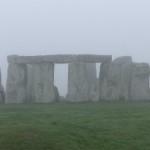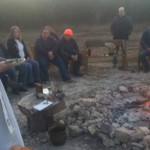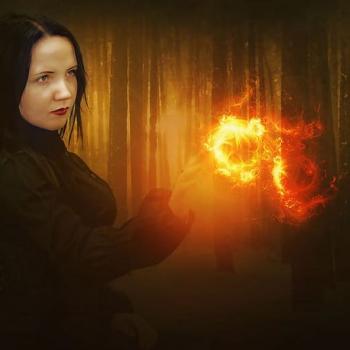Celtic Triad: Three sorrows that are better than joy: the heaviness of a herd feeding on mast, the heaviness of a ripe field, the heaviness of a wood under mast.
When does the Celtic year start? And more importantly, does it matter?
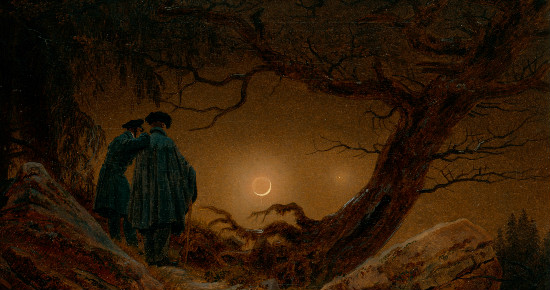
To the first question my answer is simply, I don’t know. And really, nobody does. We are pretty certain, thanks to the wonderful find of the Coligny Calendar, that Samhain marked the end of summer and the beginning of winter, and many Pagans following a Celtic path have taken this to be their new year. Samhain is a liminal period between light and dark, when the potential for change and transformation is strong. So it makes sense that in an age where we are fixated on time and date, this would be the point at which we start the year anew.
Others suggest Imbolc, because of it being a celebration of birth and new beginnings. It is the world starting to come to life again. The first splashes of green on a dusty white canvas. The first bleats of lambs under the bright winter sun.
Of course, it’s very possible that there was no Celtic New Year festival as such and that each season was marked and celebrated as another turn of the wheel, rather than a fixture within a year. It’s even more likely that different Celtic tribes followed slightly different calendars to each other. To the second question: does it matter? I don’t think so.
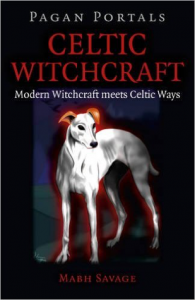 We are influenced by our ancestors, and in following a path of Celtic witchcraft we are trying to channel that inspiration into our day-to-day lives. However, this doesn’t mean you are trying to be your ancestors. You are not trying to match, action for action, word for word, how your ancestors behaved, because if we do, what is the point of the human race growing and evolving? We reach back to touch our ancestors to understand ourselves better, and to keep alive the magic and traditions of the past. But we do so in our own lives, in a modern world. So don’t get too hung up on dates and timings, and be prepared for lively debate with those who do!
We are influenced by our ancestors, and in following a path of Celtic witchcraft we are trying to channel that inspiration into our day-to-day lives. However, this doesn’t mean you are trying to be your ancestors. You are not trying to match, action for action, word for word, how your ancestors behaved, because if we do, what is the point of the human race growing and evolving? We reach back to touch our ancestors to understand ourselves better, and to keep alive the magic and traditions of the past. But we do so in our own lives, in a modern world. So don’t get too hung up on dates and timings, and be prepared for lively debate with those who do!
So what is important in a Celtic witch’s calendar? Not looking at one, for a start. To get in touch with the way your ancestors would have dealt with time and the sea ons, it’s worth trying to follow the days without resorting to dates on a piece of paper, or your smartphone. Don’t lose touch completely- after all we still have to get to work or college on time and pick the kids up and so forth! But it’s worth trying the following exercise to see if you can extend your senses into the world around you to feel the turn of the seasons rather than just note them by the date.
We all know a cycle of the moon is about 28 days. You may have at some point celebrated on a full moon, or a new moon, or simply noticed the phase marked in your diary. But have you ever noticed the changes on a daily basis? Have you ever seen the moon from one day to the next and been astonished at the difference in size, color and position?
For this exercise all you will need is a notepad (digital or otherwise) and the commitment to go outside for a few minutes every day or night. On any night when the sky is clear and the moon is visible, pop out and have a look.
What phase is the moon? Can you work out if she is waxing or waning? In the northern hemisphere, the moon waxes and wanes right to left, so if the changing ‘bulge’ is at the left, she is waxing, and if it is at the right, she is waning. If a crescent’s horns are at the right, she is waning, and if the horns are at the left, she is waxing. This is the other way around in the southern hemisphere.
Try to figure out where you are in the moon’s cycle simply by looking at the moon. Write down as much as you can; the shape, the position, the colour; is there a halo? What is the weather like? Are there any stars visible? Can you recognise any constellations? Is it just after sunset, late at night or early in the morning? What time of year is it? Close your eyes and let the moonlight wash over you. What thoughts enter your head? How does it make you feel? Finally, make a note of your general mood throughout the day.
The next day, cloud cover permitting, do the same again. Try to go out around the same time, but don’t clock watch; if you went out last night just after sunset, do the same again. If it was just before supper time, this is good enough too. You are trying to achieve a natural rhythm, rather than a strict routine.
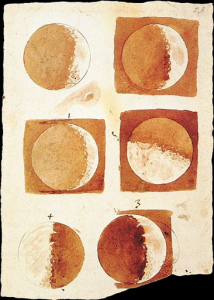
If you keep repeating this exercise on a daily basis, one day you will go out and realise that the moon is the same phase as when you began the exercise. You will feel surprised that 28 to 29 days has gone by, because you haven’t been thinking, ‘Gosh, I have to do this for a month!’ It has just been a few minutes each day, fitted in between your normal routine.
Again, note the details of the moon and the moonlit night, and most importantly, how you have been feeling that day and how you feel right now, under the moon’s gaze. Now flick back through your notes and compare this day with that first day. Are there any similarities? Was your mood very similar that day, or completely different? How has the weather changed? Has the season turned warmer or colder in that time? How has one turn of the moon affected your world? Can you feel that your local environment has changed in that time? Perhaps leaves have started to fall, or at the other end of the year perhaps you can see green buds where there were none before. Perhaps there is still a glow on the horizon from the lateness of the sunset, or a deeper black to the night sky as the evening closes in earlier.
Have you noticed any changes in yourself? Perhaps you are sleepier, or more relaxed, or tense, or excited. You have successfully used one entire ‘moon’, a proper month, to note changes not just in the world around you, but in yourself. You have a personalized almanac that can be referred back to again and again to help you extrapolate what may be happening at the same phase of the moon in the future, and at this time of year in the years to come.
I recommend keeping this exercise up for a few months as it’s really useful to see how your mood changes with the phases of the moon. You may find there is no correlation at all, but the chances are you will look back at your notes and see similar feelings and states of mind jotted at around the same phases of the moon. There are many books and sites that state ‘you will be reflective around the new moon’ or ‘the full moon will bring stress’, but the point is that everyone is affected by the moon differently. Noting how the moon affects you and your local surroundings will make you a more powerful witch, as you know when you are at your strongest and when you should rest or meditate.
This article was an excerpt From: Pagan Portals – Celtic Witchcraft: Modern Witchcraft meets Celtic Ways
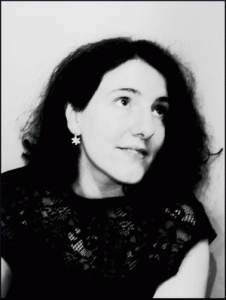 About the Author: Mabh Savage is a Yorkshire Witch, practicing a nature based craft influenced and inspired by her Celtic Heritage. Growing up with Wiccan Parents and tales of Tír na nÓg and the Tuatha de Danaan, she was drawn to Paganism herself and now writes about her experiences with Celtic deities, witchcraft and finding a connection to your ancestors. She is a trainee Bard with BDO and a passionate poet, regularly performing across the North of England. Her inspirations are her young son, her inspiring and brave partner and the incredible wealth of nature in her home county of Yorkshire.
About the Author: Mabh Savage is a Yorkshire Witch, practicing a nature based craft influenced and inspired by her Celtic Heritage. Growing up with Wiccan Parents and tales of Tír na nÓg and the Tuatha de Danaan, she was drawn to Paganism herself and now writes about her experiences with Celtic deities, witchcraft and finding a connection to your ancestors. She is a trainee Bard with BDO and a passionate poet, regularly performing across the North of England. Her inspirations are her young son, her inspiring and brave partner and the incredible wealth of nature in her home county of Yorkshire.


